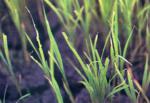Scientific name
At least three species of armyworms attack rice in Asia: the rice swarming caterpillar, Spodoptera mauritia (Boisduval); the common cutworm, Spodoptera litura (F.); and the rice ear-cutting caterpillar, Mythimna separata (Walker).
What it does
Armyworms feed on rice leaves and can also cut off young seedlings at the plant or panicle base. They feed in the upper portion of the rice canopy on cloudy days or at night.
Why and where it occurs
Armyworms live longer in areas with low temperature (15 °C maximum).
Periods of drought followed by heavy rains, and presence of many alternate hosts also sustain the development of the insect pest.
How to identify
Check for feeding damage on leaf tips or along leaf margins. Armyworms can feed on whole leaves, leaving only the midribs.
Check for cuts on stem or at plant base. The insect can also cut off panicles from base.
Armyworm damage can be mistaken for cutworm feeding. To confirm, check for the presence of the insect. The characteristic form of armyworm damage is leaf removal.
Click on images to enlarge
How to manage
To prevent
- Establish seedbeds far from large areas of weeds.
- Plow fallow land
- Remove weeds outside and inside of the field.
To control
- Flooding seedbeds is the best defense against armyworms
- Place ashes in the trenches to make it more difficult for the caterpillars to escape
- Place branches around fields to give armyworms a place to congregate where they are easily collected by hand
- Avoid killing natural enemies (e.g., wasps and spiders) of armyworms. Insecticides should be the last resort for armyworm control.
Learn more
View full fact sheet:
Armyworm on IRRI Rice Knowledge Bank


